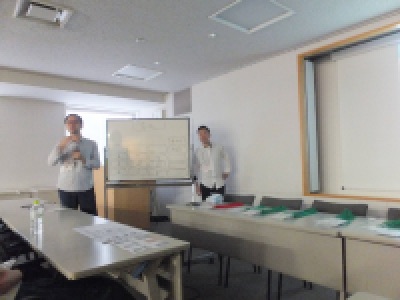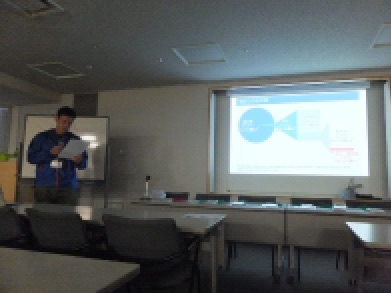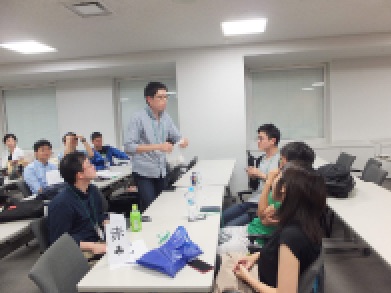1. マテリアルの紹介 Sさん

2. マテリアルの紹介 Tさん

3.ディスカッション中の様子

:::::::::::::::::::::::::::::::::::::::::::::::::::::::::::::::::::::::::::::::
《 今回のworkshop 》
○workshop参加人数:55名(うち新人の方:4名)
○【前半】:”What we’re learning from online education”
○【後半】:”Do you think that we have enough water resources? What can we do for shortage of water?”
:::::::::::::::::::::::::::::::::::::::::::::::::::::::::::::::::::::::::::::::::
みなさまこんにちは、E’s club幹事のKです。
5月26日(土)開催の第174回workshopの詳細をお送りいたします。
今回は前半のマテリアルをSさん、後半のマテリアルをTさんにご作成いただきました。
[今週のマテリアル]
≪FIRST HALF≫
“What we’re learning from online education”
Recently I feel lifelong learning is very important for me to make better life. Honestly I want to go to school. But I can’t do that in some reasons which are restricted time, unaffordable tuition, disagreement from my boss or family and so on… Sometimes the subject I’d like to take even doesn’t exist in Japan. In this case, online education can be one of the options. The one I like is “MOOC”. It stands for “Massive Open Online Course”. However it also has pros and cons.
Today I’d like to share the information about online education to encourage your discussion and l hope some of you take some courses to make your life better place.
Thank you,
Q1: Do you study something or have something you want to study? If yes, for what?
Q2: How do you or are you going to study the subject? (Location, duration, academic degrees, day time or night time etc…)
Q3: If it’s not feasible, what’s the challenge?
Q4: Do you want to take MOOC? Why?
Q5: In the future, do you think that next Albert Einstein or next Steve Jobs would be found somewhere in remote village in Africa thanks to this service?
Q6: In the future, do you think that the education gap between advanced countries and developing countries would be filled and these developing countries would catch up with advanced countries economically?
When you have time enough, please discuss the question below
Q7: What do you think about education situation in Japan?
(Reference)
TED… https://www.ted.com/talks/daphne_koller_what_we_re_learning_from_online_education/transcript
ThoughtCo.com… https://www.thoughtco.com/the-pros-and-cons-of-moocs-31030
The Pros and Cons of MOOCS
From Nathan Heller’s article, “Laptop U,” for The New Yorker by Deb Peterson
Updated March 08, 2017
Post-secondary schools of all kinds – expensive, elite colleges, state universities, and community colleges – are flirting with the idea of MOOCs, massive open online courses, where tens of thousands of students can take the same class simultaneously. Is this the future of college? Nathan Heller wrote about the phenomenon in the May 20, 2013, issue of The New Yorker in “Laptop U.” I recommend you find a copy or subscribe online for the full article, but I’ll share with you here what I gleaned as the pros and cons of MOOCs from Heller’s article.
What Is a MOOC?
The short answer is that a MOOC is an online video of a college lecture. The M stands for massive because there is no limit to the number of students who can enroll from anywhere in the world. Anant Agarwal is a professor of electrical engineering and computer science at MIT, and president of edX, a non-profit MOOC company owned jointly MIT and Harvard. In 2011, he launched a forerunner called MITx (Open Courseware), hoping to get 10 times the usual number of classroom students in his spring-semester circuits-and-electronics course, about 1,500. In the first few hours of posting the course, he told Heller, he had 10,000 students sign up from all over the world. The ultimate enrollment was 150,000. Massive.
The Pros
MOOCs are controversial. Some say they are the future of higher education. Others see them as the eventual downfall of it. Here are the pros Heller found in his research.
MOOCs:
1. Are free. Right now, most MOOCs are free or nearly free, a definite plus for the student. This is likely to change as universities look for ways to defray the high cost of creating MOOCs.
2. Provide a solution to overcrowding. According to Heller, 85% of California’s community colleges have course waiting lists. A bill in the California senate seeks to require the state’s public colleges to give credit for approved online courses.
3. Force professors to improve lectures. Because the best MOOCs are short, usually an hour at the most, addressing a single topic, professors are forced to examine every bit of material as well as their teaching methods.
4. Create a dynamic archive. That’s what Gregory Nagy, professor of classical Greek literature at Harvard, calls it. Actors, musicians, and standup comedians record their best performances for broadcast and posterity, Heller writes; why shouldn’t college teachers do the same? He cites Vladimir Nabokov as once suggesting “that his lessons at Cornell be recorded and played each term, freeing him for other activities.”
5. Are designed to ensure that students keep up. MOOCs are real college courses, complete with tests and grades. They are filled with multiple choice questions and discussions that test comprehension. Nagy sees these questions as almost as good as essays because, as Heller writes, “the online testing mechanism explains the right response when students miss an answer, and it lets them see the reasoning behind the correct choice when they’re right.”The online testing process helped Nagy redesign his classroom course. He told Heller, “Our ambition is actually to make the Harvard experience now closer to the MOOC experience.”
6. Bring people together from all over the world. Heller quotes Drew Gilpin Faust, Harvard president, regarding her thoughts on a new MOOC, Science & Cooking, that teaches chemistry and physics in the kitchen, “I just have the vision in my mind of people cooking all over the globe together. It’s kind of nice.”
7. Allow teachers to make the most of classroom time in blended classes. In what is called a “flipped classroom,” teachers send students home with assignments to listen to or watch a recorded lecture, or read it, and return to the classroom for more valuable discussion time or other interactive learning.
8. Offer interesting business opportunities. Several new MOOC companies launched in 2012: edX by Harvard and MIT; Coursera, a Standford company; and Udacity, which focuses on science and tech.
The Cons
The controversy surrounding MOOCs includes some pretty strong concerns about how they will shape the future of higher education. Here are some of the cons from Heller’s research.
MOOCs:
1. Could cause teachers to become nothing more than “glorified teaching assistants.” Heller writes that Michael J. Sandel, a Harvard justice professor, wrote in a letter of protest, “The thought of the exact same social justice course being taught in various philosophy departments across the country is downright scary.”
2. Make discussion a challenge. It’s impossible to facilitate meaningful conversation in a classroom with 150,000 students. There are electronic alternatives: message boards, forums, chat rooms, etc., but the intimacy of face-to-face communication is lost, emotions often misunderstood. This is a particular challenge for humanities courses. Heller writes, “When three great scholars teach a poem in three ways, it isn’t inefficiency. It is the premise on which all humanistic inquiry is based.”
3. Grading papers is impossible. Even with the help of graduate students, grading tens of thousands of essays or research papers is daunting, to say the least. Heller reports that edX is developing software to grade papers, software that gives students immediate feedback, allowing them to make revisions. Harvard’s Faust isn’t completely on board. Heller quotes her as saying, “I think they are ill-equipped to consider irony, elegance, and…I don’t know how you get a computer to decide if there’s something there it hasn’t been programmed to see.”
4. Make it easier for students to drop out. Heller reports that when MOOCs are strictly online, not a blended experience with some classroom time, “dropout rates are typically more than 90%.”
5. Intellectual property and financial details are issues. Who owns an online course when the professor who creates it moves to another university? Who gets paid for teaching and/or creating online courses? These are issues that MOOC companies will need to work out in the upcoming years.
6. Miss the magic. Peter J. Burgard is a professor of German at Harvard. He has decided not to participate in online courses because he believes the “college experience” comes from sitting in preferably small groups having genuine human interactions, “really digging into and exploring a knotty topic – a difficult image, a fascinating text, whatever. That’s exciting. There’s a chemistry to it that simply cannot be replicated online.”
7. Will shrink faculties, eventually eliminating them. Heller writes that Burgard sees MOOCs as destroyers of traditional higher education. Who needs professors when a school can hire an adjunct to manage a MOOC class? Fewer professors will mean fewer Ph.D.s granted, smaller graduate programs, fewer fields and subfields taught, the eventual death of entire “bodies of knowledge.” David W. Wills, professor of religious history at Amherst, agrees with Burgard. Heller writes that Wills worries about “academia falling under hierarchical thrall to a few star professors.” He quotes Wills, “It’s like higher education has discovered the megachurch.”
MOOCs will most definitely be the source of many conversations and debates in the near future. Watch for related articles coming soon.
≪LATTER HALF≫
<Agenda>
Do you think that we have enough water resources? What can we do for shortage of water?
I had never thought about shortage of water resources because I could drink tap water in comfort and find fresh water in nature like river, lake and rain, until I have several opportunities to learn about sustainable society in agricultural university I graduated from. I still can’t imagine we are facing on shortage of water in my life in Japan because I’d never felt stress. However, you may change your mind if you know about “water footprints” which I am telling you in this workshop or what the people and company try to do for resolving the issue. Let’s think it together.
<Questions>
1. With the rapid increase of population and the development of society and industry, many countries are facing a water shortage. Have you noticed the shortage of water? Or have you cared about it in your life?
2. In Japan, we are lucky to have easy access to some of the safest treated water in the world – just by turning on the tap. We consume around 300L in a day. On the other hand, people in Africa who are facing on water crisis consume around 10L. Please imagine we are facing on water shortage, what would happen to us? Let’s share what we imagine.
3. Let’s calculate our water footprint. Please access the web site below and choose one food that you ate recently, then please share how much is your water footprint.
仮想水計算機 https://www.env.go.jp/water/virtual_water/kyouzai.html
4. Have you tried to save the water in your lifestyle while many companies tried to reduce the use of water? If you have, please share how you’ve saved the water in detail.
5. It is estimated that tens of billions of cubic meters of water are used to produce the food that is imported to Japan in a year. On the other hand, Japanese self-sufficiency in food is decreasing and Japan burns or buries 3.3 million tons of commercial food waste every year. How can we make a solution for sustainable society?
<Article>
[Companies get serious about water use]
http://www.bbc.com/news/business-35613148
Water is unlike any other commodity on Earth.
For a start, we can’t live without it, for very obvious reasons.
But it also underpins pretty much every activity we pursue in life – not just in our everyday lives, but in growing food, energy production and industry both large and small-scale.
Water is also unique in that it’s pretty much indestructible – unlike most resources, it doesn’t break down when heated up, but evaporates, constantly changing form to be transported to another place at another time.
As Betsy Otto, global director at the World Resources Institute’s (WRI) Water Programme, says, “the water we drink today dropped off the nose of Tyrannosaurus rex”.
This may help explain why this most precious of resources is free. For despite being incomparably more precious than any amount of gold, platinum or diamond, in most places on Earth water holds practically no financial value whatsoever.
But water can no longer be seen as an infinite resource as shortages become ever more commonplace across the world.
Unprecedented population growth, allied with greater wealth leading to far more water-intensive meat consumption; climate change causing more erratic weather and extreme droughts; and pollution are all putting a huge strain on finite water reserves.
So much so that more than a billion people currently live in water scarce regions, according to the WRI, a number that could grow to 3.5 billion by 2025. Indeed demand for water is projected to rise by 40% in the next 20 years.
To make matters worse, food and clothing production has in recent years moved increasingly to areas of water shortages – typically developing countries that have welcomed the opportunity to establish industries, creating jobs and wealth.
Indeed water and its delivery are often cheapest in the parts of the world where it is most scarce.
As Richard Mattison, head of environmental research group Trucost, says: “If jeans were made in Denmark, fine. But they’re not, they’re produced in parts of the world that suffer from severe water stress.”
Clearly something has to give.
“We are in a race to the bottom, as if there were no supply limitations,” says Ms Otto. “That needs to change. We need to understand that we are out of balance and that there are very serious risks.”
‘Sea change’
But the message is starting to get through.
There has been a “sea change in the last five years, led by forward looking companies”, says Ms Otto, particularly in the clothing, food and drink industries.
SABMiller is just one such company. As Andre Fourie, its head of water security and environmental value, puts it, “no water, no beer!”
Acutely aware of risks to the business of water stress in the countries in which it produces – including India, Nigeria, Peru and South Africa – the UK brewer decided eight years ago to calculate its water footprint, and claims to be the first consumer goods company to do so.
It found that 90% of its water use came from growing the ingredients for its beer, such as barley and hops, rather than the actual water used to make the beer itself.
It resolved to cut its own water use by 20% by 2015, a target that was met “a little early”. It now uses on average 3.5 litres of water to produce a litre of beer, and the company has set a target of just three litres by 2020.
But it also resolved to address the wider risks of water shortages in its supply chain, for example speaking to local mining companies and farmers outside of Lima, Peru, to reduce pollution and fertiliser run-off into local rivers.
And addressing these risks is not cheap. Such are the scale of the long and short-term risks to the overall business, the company is prepared to spend serious amounts of money to secure not just its supply of water, but its quality as well.
SAB typically spends $500,000 in each locality it operates, which may be home to just one brewery.
US clothing giant Levi Strauss, best know for its jeans, is another leader in water conservation.
Five years ago, understanding that water was a “critical” issue for its business, the company initiated a drive to reduce water use in its supply chain without compromising quality.
It is now using 96% less water in making a pair of jeans – far less than the industry average of 11,000 litres.
Actions like these will “reduce operational and reputational risk, [help] manage costs and generate growth through product innovation”, says Michael Kobori, vice president of sustainability.
This initiative has saved not only one billion litres of water, but also energy consumption, and it has translated into a costs saving of 4 cents (2.8p) per pair of jeans.
Elsewhere, the consumer goods giant Unilever and the carmaker Volkswagen have spent several hundred thousand dollars on planting trees to secure their water supplies in Africa and South America.
The coffee giant Starbucks has committed millions of dollars to protect the water supply to its coffee plantations in Mexico and Indonesia.
Microsoft is even experimenting at vast expense with putting data centres under the ocean off the coast of California in a bid to reduce the water needed for cooling.
Human right
There are numerous, very real threats to water supplies for corporations the world over, primarily in agriculture, energy, utilities, IT and mining, but also in food and drink, clothing, consumer goods, retailing and beyond.
The great unknown is whether, one day, water itself rather than the delivery of it will be priced to reflect its uniquely important role in the global economy and to the human race.
Some argue that as a basic human right a price can never be put on accessing water; others that it is an unavoidable necessity.
A precedent has already been set in California and in the Murray Darling Basin in Australia, where water trading systems have been used successfully to reduce water use dramatically in times of drought.
If such schemes became widespread, the consequences for the corporate world would be dramatic.
Indeed research by Trucost suggests that more than half of the profits of the world’s biggest companies would be at risk if water was priced to reflect its value.
Companies need to act now before it’s too late.
<other reference>
If you want to know about ‘water footprints’, this article helps you.
[Researchers study products’ ’water footprints’]
www.japantimes.co.jp/news/2010/04/02/national/researchers-study-products-water-footprints/#.Wu43w7RNg4a.email=0D=0A=0D=0A=0D=0AThis
***********************************************************
私たちと一緒に英語コミュニケーション能力を鍛えませんか?
ご興味を持たれた方は、
入会申込フォーム
https://english-speaking-club.com/cms/?page_id=93
よりお申し込みください。お待ちしています!
***********************************************************